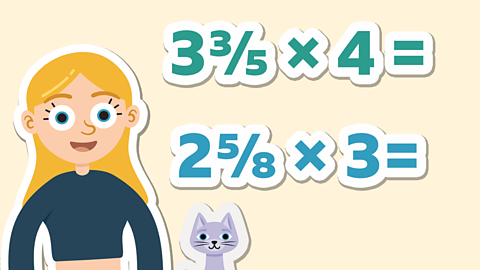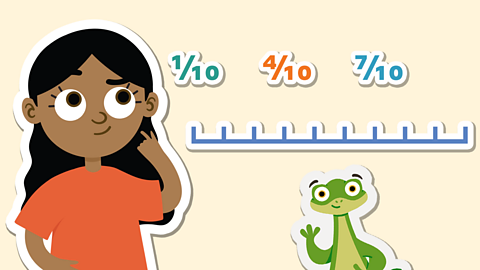Subtracting mixed numbers

When subtracting mixed numbers, you can use a similar method to subtracting two fractions, but this time you have to subtract whole numbers as well.
Remember, a mixed number is a combination of an integer (a whole number) and a fraction, like \( 3 \frac{1}{2} \).
Let's have a look at two methods for subtracting mixed numbers.

Method 1
Partition the mixed numbers into fractions and whole numbers, and then subtract them separately.
Example 1
Solve
\(5 \frac{2}{3} - 2\frac{2}{9}\)
Step 1: Partition the mixed numbers so you have whole numbers together and the fractions together.
\(\frac{2}{3} - \frac{2}{9} \)
and
\(5 - 2 \)
Subtract the whole numbers.
\(5 - 2 = 3\)
Step 2: Change one of the fractions into an equivalent fraction so both fractions have the same denominator.
You can’t simplify \(\frac{2}{9} \) any further so you have to change \(\frac{2}{3}\). 3 is a factor of 9 so multiply the numerator and denominator by 3.
\( \frac{2}{3} = \frac{6}{9}\)
Step 3: Subtract the numerator.
\(\frac{6}{9} - \frac{2}{9} = \frac{4}{9}\)
Step 4: Put the two answers from the whole numbers and fractions back together:
\( 3 + \frac{4}{9} = 3 \frac{4}{9}\)
Therefore:
\(5 \frac{2}{3} - 2\frac{2}{9} = 3 \frac{4}{9}\)
Method 1 checklist

- Partition and subtract whole numbers
- Check and change denominators
- Subtract the numerators
- Whole numbers answer + fractions answer = final answer

Method 2
Change the mixed numbers into improper fractions.
Remember, an improper fraction is a fraction where the numerator is greater than the denominator, like \(\frac{9}{5}\).
Example 2
Solve
\(2 \frac{1}{5} - 1 \frac{5}{25}\)
Step 1: Convert the fractions so that they have the same denominator.
The denominators are 5 and 25.
5 goes into 25, so \(\frac{5}{25}\) is equivalent to \(\frac{1}{5}\).
\(1 \frac{5}{25} = 1 \frac{1}{5}\)
Step 2: Convert the mixed numbers into improper fractions.
To do this, multiply the integer (whole number) by the denominator, and then add that to the numerator.
\(2 \frac{1}{5} - 1 \frac{1}{5}\)
becomes
\( \frac{11}{6} - \frac{6}{5}\)
Step 3: Subtract the numerators.
\(\frac{11}{5} - \frac{6}{5} = \frac{5}{5}\)
\(\frac{5}{5}\) is one whole, so it can be written as 1. So:
\( 2 \frac{1}{5} - 1 \frac{5}{25} = 1\)
Method 2 checklist

- Check and change denominators
- Convert to improper fractions
- Subtract the numerators
- If needed, convert answer back to a mixed number

Example 3
Solve
\(3 \frac{1}{9} - 1 \frac{4}{9}\)
Which method would be best?
Method 1 would need you to subtract \(\frac{4}{9}\) from \(\frac{1}{9}\). This is difficult to solve as it involves exchange.
As the denominators are the same, it is easier to use Method 2. Convert the mixed numbers into improper fractions.
\(3 \frac{1}{9} = \frac{28}{9}\)
and
\(1 \frac{4}{9} = \frac{13}{9}\)
Subtract the numerators.
\(\frac{28}{9} - \frac{13}{9} = \frac{15}{9} = 1 \frac{6}{9}\)
Activities
Quiz 1
Apply what you have learnt from this guide to the quiz! Tap on the correct answers.
You may need a piece of paper and pen to write down your working out.
Quiz 2
Play our fun maths game Guardians: Defenders of Mathematica. gamePlay our fun maths game Guardians: Defenders of Mathematica
Use your times tables and more maths skills to defeat monsters and reclaim the Kingdom of Mathematica

More on Fractions
Find out more by working through a topic
- count7 of 26

- count8 of 26

- count9 of 26

- count10 of 26
